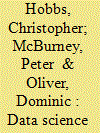| Srl | Item |
| 1 |
ID:
166864


|
|
|
|
|
| Summary/Abstract |
International concern over nuclear terrorism has grown during the past few decades. This has driven a broad spectrum of efforts to strengthen nuclear security globally, including the widespread adoption of radiation-detection technology for border monitoring. Detection systems are now deployed at strategic locations for the purported purpose of detecting and deterring the smuggling of nuclear and radioactive materials. However, despite considerable investment in this area, few studies have examined how these programs are implemented or the operational challenges they face on a day-to-day basis. This article seeks to address this with a focus on radiation-detection efforts at maritime facilities. Utilizing practitioner interviews and a survey, this article identifies the factors that influence the planning and use of these systems in this fast-moving environment. The results clearly demonstrate that the implementation of these systems varies significantly across different national and organizational contexts, resulting in a fragmented global nuclear-detection architecture, which arguably undermines efforts to detect trafficked nuclear-threat materials. Greater consideration should therefore be given to developing international standards and guidance, designing and adopting tools to support key parts of the alarm assessment process, and broader sharing of good practice.
|
|
|
|
|
|
|
|
|
|
|
|
|
|
|
|
| 2 |
ID:
177822


|
|
|
|
|
| Summary/Abstract |
Radiation detection technology is widely deployed to identify undeclared nuclear or radiological materials in transit. However, in certain environments the effective use of radiation detection systems is complicated by the presence of significant quantities of naturally occurring radioactive materials that trigger nuisance alarms which divert attention from valid investigations. The frequency of nuisance alarms sometimes results in the raising of alarming thresholds, reducing the likelihood that systems will detect the low levels of radioactivity produced by key threat materials such as shielded highly enriched uranium. This paper explores the potential of using data science techniques, such as dynamic time warping and agglomerative hierarchical clustering, to provide new insights into the cause of alarms within the maritime shipping environment. These methods are used to analyze the spatial radiation profiles generated by shipments of naturally occurring radioactive materials as they are passed through radiation portal monitors. Applied to a real-life dataset of alarming occupancies, the application of these techniques is shown to preferentially group and identify similar commodities. With further testing and development, the data-driven approach to alarm assessment presented in this paper could be used to characterize shipments of naturally occurring radioactive materials at the primary scanning stage, significantly reducing time spent resolving nuisance alarms.
|
|
|
|
|
|
|
|
|
|
|
|
|
|
|
|